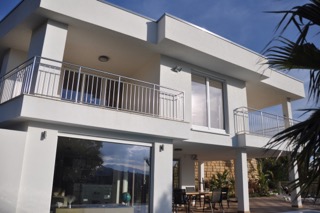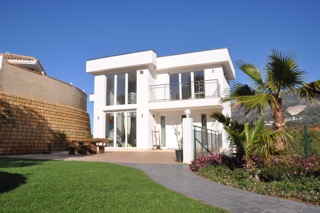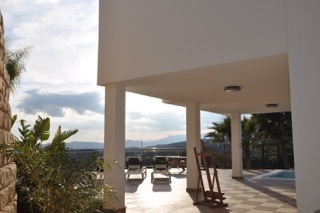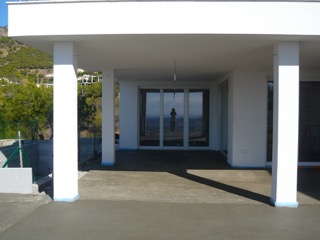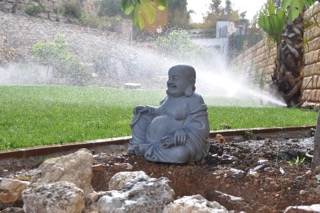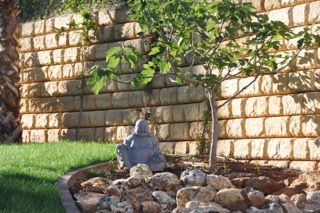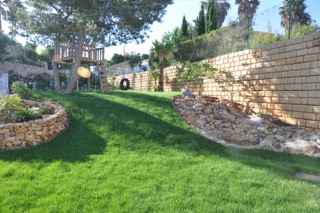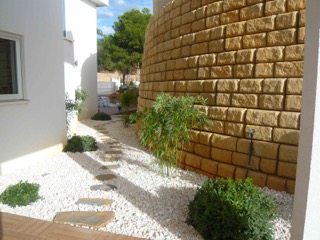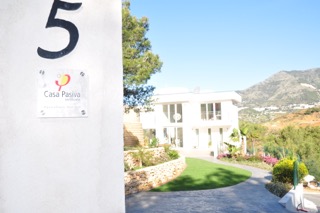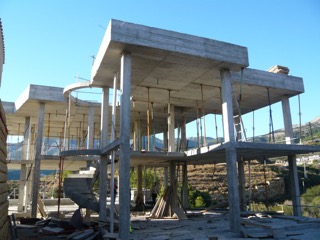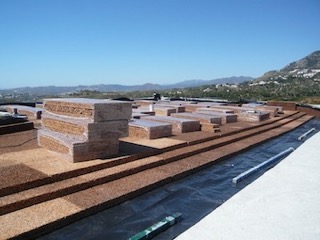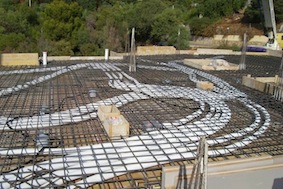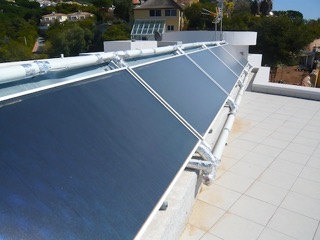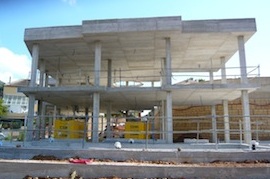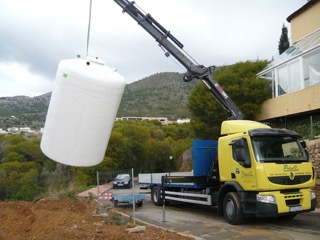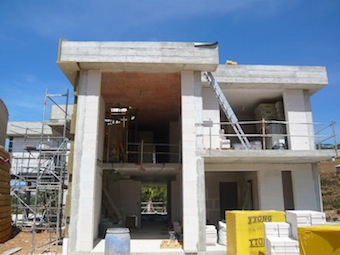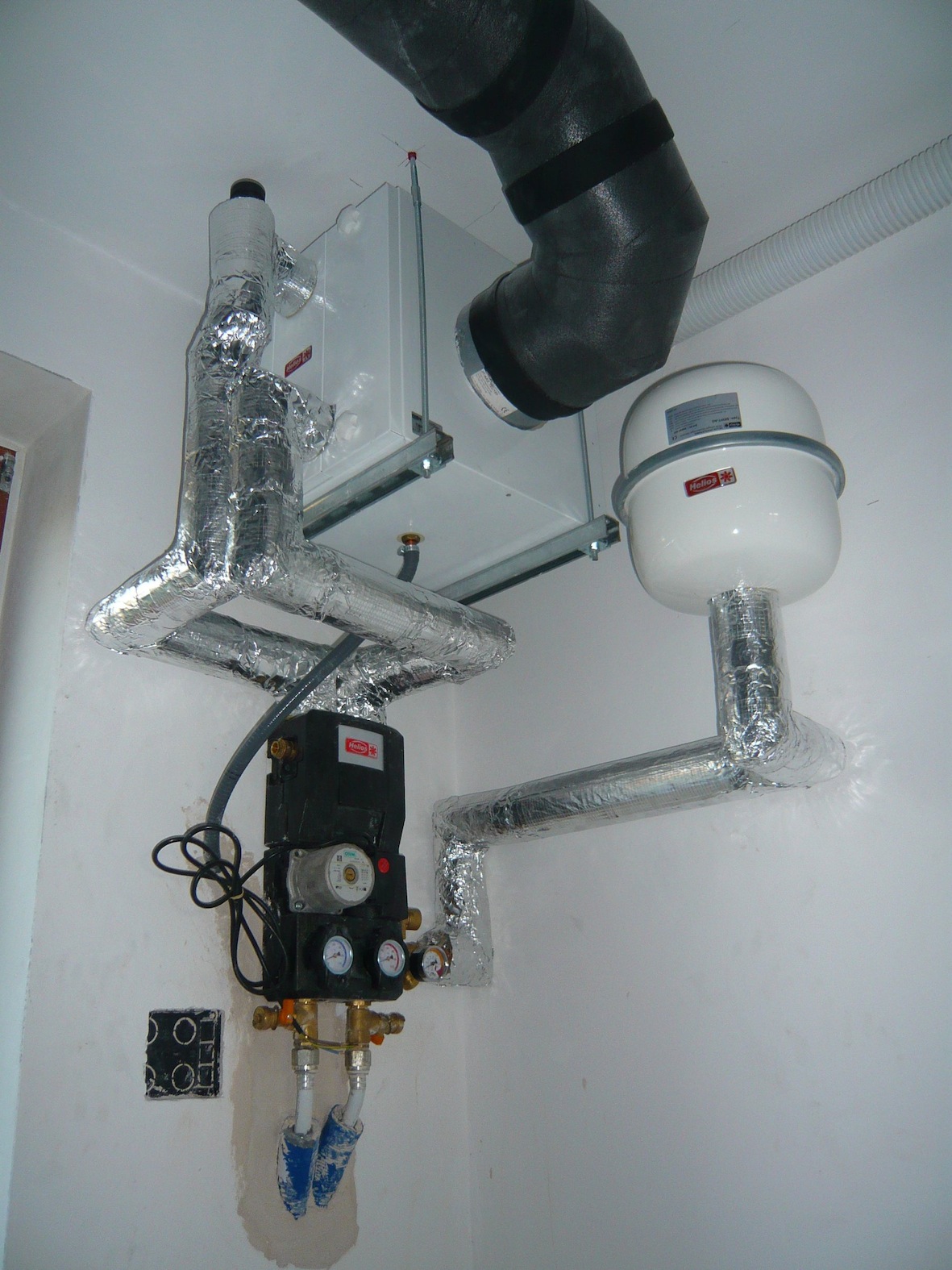Villa "Sol y Viento"
Mediterranean passive house in the province of Málaga, completion: 2015

Attending Architect and Structural Engineer: Estudio Técnico Vera
General contractor: Casa Linda S.L.
Heated floor area: 400m2
If you are interested in visiting the house, we will be happy to organize a visit for you including a charla about passive houses. Please get in contact with us.
Additional information can be also found at www.passivhausprojekte.de ID: 4477
Special Features

Large flat roof for active use of photovoltaics and solar thermal energy.

Automatic solar shading control for blinds via KNX building automation.

Overnight cooling during summers via thermal buoyancy (3 floors plus tower).

Use of an air source heat pump to support hot water supply during winter.

Upstream ground heat exchanger for pre-warming or pre-cooling of ventilation system.

Rainwater utilization system for garden irrigation and toilet flushing.

Heat transfer coefficients (W/m2K).

U-value exterior wall: 0.22 W/(m2K).

U-value exterior wall/ground: 0.27 W/(m2K).

U-value basement floor: 0.24 W(m2K).

U-value roof: 0.21 W/(m2K).

U-value windows: 1.3 W/(m2K).

Heat recovery: 80.31%.

PHPP annual heating demand: 8.8 kWh/m2a.

PHPP annual cooling demand: 5 kWh/m2a.

PHPP primary energy demand: 78 kWh/ (m2a).

Pressure test air exchange n50: 0.5 1/h.
The Building Process
-
Building StructureThe house is supported by a reinforced concrete framework that was infilled with aerated concrete blocks (Ytong). The ceilings are solid reinforced concrete slabs. The roof is an overhanging flat roof, from which a stair tower protrudes.
-
Thermal Insulation ConceptThe entire building is covered with thermal insulation.
Beneath the basement floor slab (6cm) as well as on the building components touching the ground (12cm) and under the south-facing terrace (15cm), Styrodur insulation was applied.
On all exposed exterior walls, a 12cm thick thermal insulation composite system made of mineral wool was applied.
The roof surface was insulated with 18cm chipboard cork, the balcony surfaces with 10cm chipboard cork.
Our intention was to avoid thermal bridges as much as possible in the construction, for example all exposed concrete balcony slabs were covered with 6cm thermal insulation in order to keep the transition between the interior and exterior concrete ceiling free of thermal bridges. -
The WindowsFor the windows, we chose high-quality aluminum-clad wood windows with double panes and triple panes.
The majority of the windows are equipped with exterior blackout blinds. Care was taken to choose a particularly well-insulated blind cassette, which was equipped with additional insulation on the front and back. A thermal bridge calculation for this is available. -
Ventilation System ConceptWe installed two different ventilation systems in the house in order to gain experience with different suppliers.
The ventilation ducts were embedded in the concrete ceiling. From the two centrally installed distribution boxes on the ground floor and in the basement, an individual duct leads to each air vent or air inlet in the house. This allows all living spaces in the house to have their own individual air supply. All kitchens, bathrooms and storage spaces have individual exhaust ducts. Corridors and walk-through areas are overflow zones. -
Airtightness Concept and Blower Door Pressure testTo ensure the airtightness of the building envelope, precautions were taken not to break through the airtight layer or to only break through it in a few well-sealed places.
A position map showing the airtight envelope was created. The implementation details for several transitions are available.
The concrete ceiling and the concrete floor form the upper and lower border of the airtight layer, respectively. The entire surface area of the aerated concrete walls was sealed with airtight plaster, and the plaster was connected to the ceiling and the floor.
Special care was taken to apply the plaster all the way down to the floor before installing the screed as well as to plaster the entire surface of the bathroom walls prior to installing the interior plumbing walls.
Plumbing pipes were sealed with airtight adhesive tape.
Airtight electrical sockets were installed in the exterior walls as well as in areas of the interior walls within 1m of the exterior walls.
The tower roof is the only roof that was designed as a wooden construction. The airtight layer is formed by an airtight foil that transitions into the plaster of the wall.
The windows were equipped with a special airtight sealing tape and glued to the reveals underneath the plaster.
All floor-level windows were sealed with a special airtight and waterproof foil from the outside as well as the inside.
A blower door test was performed and successfully passed with an n50 value of 0.469 air exchange rate. -
Building Equipment | Cooling Concept - SummerTightly closing exterior blinds were installed on the windows to protect the house from too much heat input during summer. These blinds are controlled based on the position of the sun and/or timer via KNX building automation to ensure that the heat input during summer does not become too great even in case of absence.
In addition, the main south-facing windows are protected and shaded from the sun’s vertical position during summer by generous canopies.
At high summer temperatures, the house is additionally cooled down at night by manual ventilation.
The intake air on the ground and first floors is pre-cooled by a ground-coupled heat exchanger during summer. Based on the first summer experiences the ground-coupled heat exchanger can achieve a temperature reduction of two degrees Celsius for air entering the rooms. -
Heating Concept - WinterThroughout the year, heat gains are primarily achieved via solar yield through the windows. Southern Spain receives nearly 3000 hours of sunshine per year. The solar energy yield is correspondingly high. On the east-facing side, we have incorporated large two-story windows to capture solar energy beginning in the early morning hours.
Through these windows in the east, solar energy can reach into the heart of the house until noon and heat the indoor air. Because of the sun`s lower position during winter, solar energy can also enter the large windows beneath the canopies in the south and west as the day progresses.
In addition, the house`s intake air is slightly pre-warmed by a ground-coupled heat exchanger and the ventilation unit`s heat recovery.
For cooler winter days or for times with many cloudy days, the house is equipped with central heating that is independent of the ventilation: a 1,000-liter hot water tank supplies not only hot drinking water, but also supplies an underfloor heating system that explicitly heats the bathroom floors as well as the main floor surfaces of the common rooms on the ground floor and in the basement (see floor heating plan).
The tank primarily runs on solar thermal energy from 5 elevated solar panels that are installed on the flat roof.
During summer, the solar thermal system transfers excess heat to the outside pool.
Especially on cloudy days, the hot water supply is supported by an air-source heat pump, which also feeds the storage tank when solar energy is insufficient. -
Implementing a Zero-Energy-HouseThe final aim for this building project was already determined at the beginning of the planning period. It was to be planned holistically and designed so that the Passive House could later become a Zero-Energy House with the help of a PV system on the roof. In addition, the garage has been equipped with an outlet suitable for charging an electric car in the future. A concept for a PV system on the flat roof in the order of 5-6 kW has already been developed and will be implemented in the near future.
-
Green Building MaterialsIn the selection of building materials for the house, both the price-performance ratio as well as various environmental factors were considered.
In large part, we opted to use environmentally responsible building materials.
For example: Wooden windows made of pinewood were used instead of windows made of tropical hardwood or PVC.
The roof and the balconies were insulated with chipboard cork.
Mineral wool was used in the thermal insulation system of the exposed exterior walls.
The interior areas were primarily painted using solvent-free eco paint. -
Rainwater TankOn the flat roof, the house has around 190m2 of roof surface area to collect accumulating rainwater. In addition, a surface area of 110m2 from the south- and east-facing terraces is also connected to the rainwater system. In this region, rain falls mainly during the winter months, while it hardly rains at all during the summer months. For this reason, a relatively large storage volume of 16m3 was selected for the rainwater tank, which is buried underground in the garden. This allows for collected rainwater to supply the majority of the garden irrigation during winter as well as the water for toilet flushing. This water tank is saving about 80m3 of fresh water every year.
Open all Close all
The Building Process Gallery


